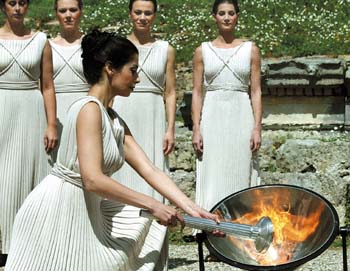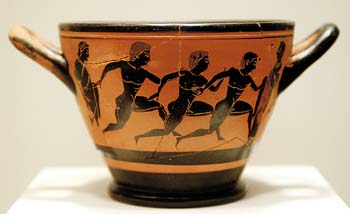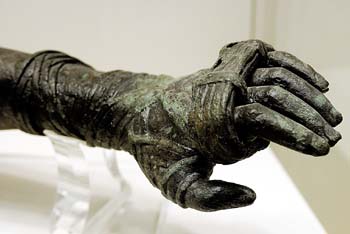Competing against ancient myths
Scholars challenge long-held beliefs of early Olympics
08/08/04
By Joseph B. Verrengia
Associated Press
It was like the Super Bowl, Woodstock, Mardi Gras, a holy
pilgrimage and Chippendale dancers all rolled into one.
 |
Greek actresses dressed as high priestesses
take part in a dress rehearsal March 24 at Ancient
Olympia on the eve of the official flamelighting
ceremony for the Olympic Games. In ancient time,
contestants roasted meat and offereings in the sacred
flame. Photo by AP |
The setting for the earliest Olympic Games some 3,000 years
ago was a sanctuary of soaring marble temples and a foul,
drunken shantytown plagued by water shortages, campfire smoke
and sewage. The athletes, glistening from olive oil, competed
naked. Gymnasiums were restricted to keep the sex trade from
overrunning events on the field.
With the 2004 Summer Games set to begin this week in
Athens, archaeologists and scholars are demythologizing and
viewing the original Olympics as they really happened.
Contrary to the modern stereotype, the Games weren't
tightly scripted Homeric epics in which warriors dropped their
weapons every four years to honor the twin virtues of amateur
sport and brotherhood.
While the Olympics' 3,000-year history is dotted with the
heroic champions like the wrestler Arrhichion who fought to
the death, researchers say they also were plagued by cheating,
scandal, gambling and outsized egos.
"The ancient Greeks were not as idealistic as we represent
them to be," says David Gilman Romano of the University of
Pennsylvania Museum and director of a new excavation at Mount
Lykaion, 17 miles from ancient Olympia. "They had many of the
same problems we have today."
The ancient Games were held in a remote valley.
Forty-thousand spectators crowded a hillside above a sacred
precinct containing some of the greatest temples in the
empire. Sport, they believed, was a high tribute to the gods,
who favored the athletes who won.
 |
A
painted vessel showing runners and dated 540 B.C. is on
display at an exhibition at the National Archaelogical
Museum in Athens. The exhibition "Agon" -- the Greek
word for contest -- will run through Oct. 31. Photo by
AP |
Before the Games, athletes pledged their piety as they were
paraded past a row of statues of gods and former champions
that were paid for from the fines of disgraced cheaters. At
the feet of a 40-foot statue of Zeus -- one of the seven
wonders of the ancient world -- they sacrificed oxen and boar
and roasted hunks of the flesh in a sacred flame.
Then the Games would begin, lasting five days. The athletes
would consult fortunetellers and magicians for victory charms
and potions -- the ancient precursors to steroids, classics
experts say -- as well as curses on their opponents to fail.
The first recorded incident of actual cheating occurred in
388 B.C. when the boxer Eupolus of Thessaly bribed three
opponents to take a dive.
Others were induced to swap allegiance, often at the risk
of exile from their homelands. The city-state of Syracuse was
as notorious as New York Yankees owner George Steinbrenner in
its quest for free agents that would bring religious favor and
glory.
When Syracuse induced sprint champion Astylos to quit
Kroton in southern Italy, fans in his hometown tore down his
statue and turned his house into a prison.
Olympic corruption peaked under Roman influence; in A.D.
67, emperor Nero bribed the judges to include poetry reading
as an event. They also declared him the chariot champion,
overlooking that he fell out and never finished the race.
For the fractious city-states of the empire, the Games held
every four years offered a slightly less violent respite from
their near-constant state of war. Athletes and spectators from
all parts of the realm were promised safe passage to and from
the neutral site.
The experience of competing against -- or cheering
alongside -- battlefield rivals brought out the best and worst
in human nature, especially when immortality was at stake.
 |
The
arm of a boxer from a statue from the late 2nd century
B.C. is part of the exhibition at the National
Archaelogical Museum in Athens. Photo by AP
|
"Sport was sort of like war," says University of
Texas-Arlington classical history scholar Donald G. Kyle.
"Participation wasn't enough. They wanted to win so badly, and
they feared losing so much. What we're willing to do to win
says an awful lot about our societies."
Archaeologists have uncovered some evidence of the
complexity of the ancient Games in excavations at Olympia and
other sites that hosted preliminary contests, including discus
fragments, javelin points and metal objects that could be
prizes or religious votives.
Greek art adds rich visual details to the historical
record, with paintings on vases, urns and other fine pottery
the most important source. They depict disfigured boxers with
bloody noses and sprinters thundering down the track, elbows
flying. Judges flogged the athletes for transgressions ranging
from false starts on the track to eye gouging in the ring.
Literary sources offer still more details, from florid
victory odes to inscriptions on statue pedestals.
Experts differ on the number of Olympic events. Was it 14
or 18? The mule cart race was held for just 56 years in the
5th century B.C. And, should the competition for heralds and
trumpeters be counted? Regardless, the Games were considerably
smaller than the 300 rounds of competition staged now with
10,500 athletes from 202 nations.
A few events have persisted over the millennia, like the
discus, javelin, running, wrestling and boxing -- although the
ancient versions often had different rules. Other events
vanished with the empire, like the full-armored sprint and the
pankration -- which resembled a bar fight that allowed
finger-breaking and genital punching.
Only first-place winners were symbolically crowned with
laurel wreaths, but the rewards hardly ended there. Today's
concept of amateur status would've been foreign in ancient
Greece.
These champions were the Michael Jordans of their day,
showered with fame and prizes, including huge annual stipends
and prized commodities like the best olive oil, free meal and
theater seats, hometown parades, statues and sex partners.
The shamed losers, according to the poet Pindar, would
"slink through the back alleys to their mothers."
Excavation of athletic facilities show differences with
modern stadiums, too. Instead of today's oval tracks, the
straight track, or stade, at Olympia is 198.28 meters. Runners
raced its length and rounded a post at the far end. In some
events, they might do this 15 times.
The first Olympic champion was a cook named Koroibos who
ran in 776 B.C. Perhaps the greatest runner was Leonidas of
Rhodes, who won all three footrace events in four consecutive
Olympics beginning in 164 B.C.
The balbis, or starting line, in Greek tracks usually was
made of stone blocks set in the ground; runners would wedge
their toes into parallel grooves carved in the stone, leaning
forward.
Seventy miles from Athens at Nemea, reconstructions by
University of California-Berkeley archaeologist Steven G.
Miller suggest races were controlled by a judge standing in a
manhole behind -- and below -- the poised runners. He pulled
tight on ropes that kept a hinged gate upright. When the
trumpet blared, the judge dropped the ropes, the gates fell
and the runners took off.
In later centuries, the whole system -- called a hysplex --
became more automated by pulleys and a spring.
Also at Nemea, Miller has excavated the locker room where
athletes slathered themselves with oil, and the vaulted tunnel
that leads to the track. Its walls are still bear their
graffiti, some of it reflecting the homoerotic nature of the
ancient games.
Miller cites an example in which one athlete praised the
physique of another, writing, "AKROTATOS KALOS" or "Akrotatos
is beautiful." Another athlete wrote "TOU GRACANTOS" or "to
the guy who wrote it!"
That the ancient Games were a very human spectacle of
blood, sweat, sex, money and stench doesn't diminish their
historical and cultural importance, experts say.
Nor should it tarnish the athletes' achievements.
That becomes clear if you were to stand at the end of a
hot, long ancient track -- fully clothed, presumably -- and
pretend that your name is Leonidas, ready to run.
"It really is a thrill," Miller says, "to be a part of
ancient Greece, if only for a few minutes as you come out of
the locker room, through the tunnel, to put your toes in the
ancient starting grooves."
| 